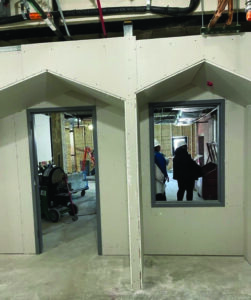By Obersy Robles Valdez
The Scene staff

It’s been more than 12 years since Forest Park closed its child-care center, causing widespread controversy in the campus community.
The college announced last year that it would bring back the center, and officials now expect it to open during spring semester.
“Not only is it a teaching center for children, but it is also a teaching center for our own students,” said Julie Fickas, campus president.
Fickas was referring to plans for center staff to include students majoring in early childhood education. That will allow them to get hands-on experience in the field.
At any given time, the center will be able to accommodate 60 children, including those of students, faculty and staff.
“I believe that it’s a great idea,” said biology major Clarisse Gibonio, 18, a student who has a friend with a newborn baby.
Workers have been renovating the physical education building on campus for close to a year, turning 10,000 of its 19,000 square feet into the child-care center.
The total cost is estimated at $10 million.
The center will consist of a lobby, classrooms, a conference room, playroom and an outdoor playground where the softball field used to be.
“It will be organized with brand new signs,” Fickas said. “When people walk in, we want to give that experience of being at home and being in a comfortable environment.”
The remaining 9,000 square feet of the P.E. building will provide reduced space for fitness activities, including a yoga room, updated weight room and new gym that is smaller than the original.
The indoor swimming pool will remain intact.
Programs and services at Forest Park’s child-care center will be modeled after the one on the Florissant Valley campus, according to Mariela Tapia-Alpaslan, St. Louis Community College manager of engineering and design.
“The child-care center will have dedicated offices and a conference room for faculty and staff,” she said.
STLCC plans to pay for the project with a $4 million Missouri Department of Elementary and Secondary Education grant that uses funds from the federal CARES (Coronavirus Aid, Relief and Economic Security) Act. The remaining $6 million will come from the college’s capital fund budget.
Officials originally expected renovations to be completed by December, but supply chain issues caused delays, Tapia-Alpaslan said. She expects work to resume next month.
“We are shooting for the child-care center to open sometime in the spring next year,” Tapia-Alpaslan said.

The former Forest Park Children’s Center opened in 1995, giving students, faculty and staff a place to leave their children while attending classes or working. Services were cheaper than those at private facilities.
Many people were caught off guard on Nov. 19, 2009, when the STLCC board voted to follow an administrative recommendation and close child-care centers on the Forest Park and Meramec campuses, even though it wasn’t on the meeting agenda.
“In reviewing the overall operations of the college, and with more and more individuals seeking our services, we must put dollars toward initiatives that improve the learning outcomes and academic achievement of all our students, as well as those that address evolving workforce needs,” Trustee Joan Ordinachev explained at the time.
The college was reportedly spending $600,000 a year subsidizing the Forest Park and Meramec child-care centers, including $53,400 to rent an off-campus building near Forest Park. They were serving the children of 209 students, faculty and staff in 2009.
The Forest Park center closed on June 30, 2010. Housekeeping employees threw away bins full of games, toys, books and other items. The STLCC board decision was publicly criticized by center managers and parents whose children were enrolled.
“The center is the only reason why I was able to change my personal situation and start school and complete my dream of becoming a lawyer,” said former student Daniella Yussupbek. “Personally, I consider this discrimination against single parents and low-income families.
“Students were crying after hearing the speeches of each other’s personal stories of how their life goals and dreams will have to change as a result of closing the center.”
